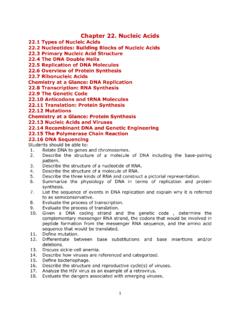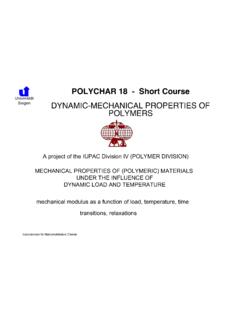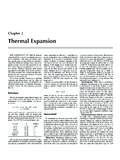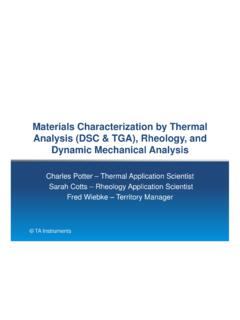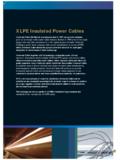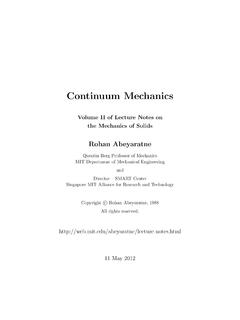Transcription of Introduction to TG/DTA/DSC - latech.edu
1 Thermal Processing Technology CenterIllinois Institute of TechnologyIntroduction to TG/DTA/DSCO utline Introduction Theory of TG/DTA/DSC Application of TG/DTA/DSC TG/DTA/DSC in Metallurgy application Experiment difficultyApplication of Thermal Analysis in Material Research The almost universal applicability of thermal analysistechnique has led to their use in nearly every field of science, with a strong emphasis on solving problems in materials technology and engineering, as well as "pure" scientific investigations. The change in physical properties of a substance subjected to a controlled temperature program as afunction of temperature is measured. Techniques Include TG, DTA, DSC, DMA, TMAI ntroduction to TG Thermogravimetry is a technique measuring thevariation in mass of a sample when it undergoestemperature scanning in a controlled variation in mass can be either a loss of mass (vapour emission) or a gain of mass (gas fixation).
2 Introduction to DTA Differential thermal analysis is a technique measuring the difference in temperature between a sample and a reference (a thermally inert material) as a function of the time or the temperature, when they undergo temperature scanning in a controlled DTA method enables any transformation to be detected for all the categories of materials. Introduction to DSC Differential scanning calorimetry is a technique determining the variation in the heat flow given out or taken in by a sample when it undergoes temperature scanning in a controlled heating or cooling any transformation taking placein a material is accompanied by a exchange of heat ; DSC enables the temperature of this transformation to be determined and the heat from it to be of TG (Thermogravimetry) Measure the mass of sample as a function of temperature Determine sample purity, decomposition behavior, chemical kineticsTheory of DTA (Differential Thermal Analysis) The temperature difference between reference and sampleis monitored as a function of temperatureTheory of DSC (Differential Scanning Calorimetry) The difference in heat flow to or from a sample and to or from areference is monitored as a function of temperature or time, while thesample is subjected to a controlled temperature programPower compensated DSCT heory of DSC (Differential Scanning Calorimetry)
3 Temperatures are measured in thin plates in contact with those,thereby measuring the difference in heat flow from crucible. Thisgives a signal proportional to the difference in heat capacitiesbetween the sample and reference and thus the instrument will work as flux DSCD ifferent principles of DSC signal detectionDifferent principles of DSC signal detectionThe difference between DTA and DSCDTAT emperature difference is measured, amplified and recorded. The peak area can be converted to heat only if a suitable reference is usedDSCThe temperature difference is controlling the electrical power to the sample and reference in order to keep them at the same temperature. The peak area directly corresponds to the heat consumed or produced bythe sampleModern DTA (also called heat flow DSC)Temperatures are measured in thin plates in contact with those, therebymeasuring the difference in heat flow from crucible.
4 This gives a signal proportional to the difference in heat capacities between the sample and reference and thus the instrument will work as DSC. Application of TG Study thermal degradation Chemical reaction resulting in changes of mass such as absorption, adsorption, desorption Sample purityApplication of DTA Primarily used for detection of transition temperature Sample purityApplication of DSC Determination important transition temperatures Determine heat of fusion of a crystal phase and the degree of crystallization Study crystal kinetic Determine heat capacity Determine heat of formation Sample puritySummaryMeasure heat flowdifference betweenreference and sampleMeasure temperaturedifference betweenreference and sampleMeasure the mass of sampleTheoryDSCDTATGYesNoNoQuantitative analysis ofheat changeYesYesNoQualitative analysis ofHeat changeNoNoYesMass changeDSCDTATGA pplicationProgram experiment temperatureDSC curveTG-DTA curve of CuSO4-5H2 OCp determination Instruments
5 Calibrated by a standardCCpp= cm(AA)m(AA)csbscbtimeHeat flow ( V)AbAsTAc Metallurgy ApplicationPhase transformation and melting of IronResults Different events may be observed during the heating : at 769 C : curie point at 924 C : transition at C transition at C : melting of ironTemperature/ 20040060080010001200 Heat Flow/ -80-70-60-50-40-30-20-10 Exo769 C924 C1404 C1551 C1 : Point de curie2 : Transition alpha --> Gamma3 : Transition Gamma --> Delta4 : Fusion1234 Metallurgy applicationOxydation of a steel in the scanning modeTemperature/ % % 700 C a mass gain is observed : the DTG shows two steps in the 700 C a mass loss applicationReduction of a steel at 1200 CTime/ % 1000110012001300 TTGR esultsAt 1000 C a small mass gainis observed due to traces ofO2and H2O.
6 But when thetemperatureof1200 Cisreachedastrongmassdecrease corresponding to thesteel reduction is applicationIsothermal transformation of a high speed steelFirst heatingTime/ Flow/ mW123456789 Temperature/ 100200300400500600 ExoSecond heatingTemperatureResultsWhenthetemperat ureisstableat560 Calowexotherm can be observed,the DSC curve the isotherm of 3 hoursthe same sample is cooledthen heated a second time inthe same difference between thetwosuccessivetracescorrespond to the sampletransformation at 560 applicationMelting of a Cu-Ti intermetallic compound5006007008009001000-250-200-150- 100-50050 ExoOnset point 1 : 925,2 COnset point 2 : CEnthalpy / J/g : (Endothermic effect) ( + ) C12 Heat Flow ( V)Temperature ( C)ResultsA double peak of melting onset peak of the firstfraction is 925 top of the second fractionis 978 total heat of melting aplicationMelting of Pb-Sn alloy175200225250275300325-30-25-20-15-1 0-5 0 Exo-------------Sn/ Pb :86/ 14 Top of peak2 :213.
7 2 CTop of peak1 :186. 9 CEnt h2:- 33. 679 J/ gEnt h1:- 20. 212 J/ gT. Onset:183. 5 CEnt h:- 53. 891 J/ g12 HEAT FLOW/mWTEMPERATURE/ CResultsThe melting curve presentstwo peaks. In fact only puresubstances melt presenting aunique peak : generally alloyspresentamorecomplexmelting curve. In this case Pban Sn present an eutectic C. The end of meltingcorresponds to the liquidscurve. M 119 presents applicationPhase diagram of Pb-Sn system20406080100175200225250275300325 TEMPERATURE / CSn0Pb386586 ResultsThe onset temperatureof the melting curvegenerallycorrespondsto the eutectictemperatureof the system. Thetemperatureof liquids is given by the top of the peak of difficultyExplanation of experiment result Some curves might not be smooth and sharpSystem error The error of commercialized instrument is about 5% The measured thermodynamic property can be applied to modeling only if the error is less than 1%Crucible selection Crucible should not react with sampleTemperature setting The higher temperature, the more problems - high sample vapor pressure- high sample diffusivity- short life timeMetallic sampleBNReacting gasWMetallic sampleAl2O3 Nonmetallic samplePtConditionCrucible materialSetaram calorimeterSetsys1750.
8 TGTG/DTATG/DSCT hermal analytical techniques, abbreviation andproperties investigatedTechniqueAbbreviationPhysica l properties thermodilatometry-length ThermogravimetryTG(TGA)mass Derivative thermogravimetryDTGmass Differential Thermal AnalysisDTAtemperature Differential Scanning CalorimetryDSCenthalpy thermomechanical AnalysisTMAdimension Dynamic mechanical AnalysisDMAstiffness & damping Thermally Stimulated CurrentTSCdipole alignment/relaxation Dielectric AnalysisDEAdielectric permittivity/loss factor Evolved Gas AnalysisEGA gaseous decomposition products Thermo-optical AnalysisTOAoptical properties




